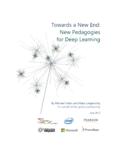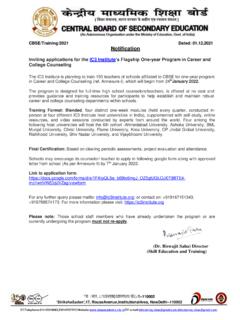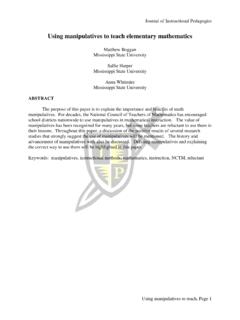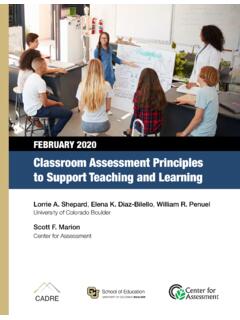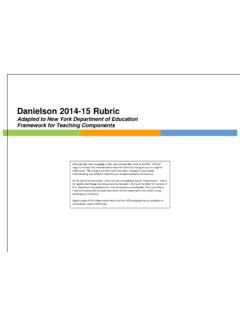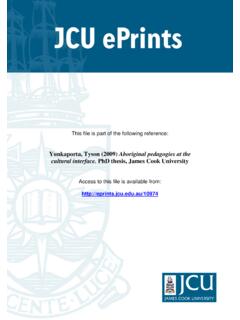Transcription of The New Teachers’ Standards 2012 Possible Evidence
1 Name: School: The New Teachers Standards 2012 Possible Evidence 2 31. Set high expectations which inspire, motivate and challenge pupils a) establish a safe and stimulating environment for pupils, rooted in mutual respect - Safeguarding practice matches policy - Class environment how does environment support and extend learning? - Attendance and punctuality; bullying log/ behaviour log - Opportunities for learning outside school day; completion of homework - Pupil behaviour in lessons: behaviour systems promoting learning, peer feedback - Possible rewards and sanctions (including celebration assemblies, class assemblies) - Relaxed atmosphere within class pupil talk; confidence to speak and discuss; respect for opinions - Lesson observation and learning walks.
2 Portfolio of (stimulating) displays & learning walls (which represent minorities disabled, ethnic groups, etc.) - Student voice especially look for stimulating environment & high expectations; peer mediators; pupil questionnaire - Cross-phase/ mixing year groups - Use of external agencies - Induction systems at start and middle of the year - Ability to work with parents/carers to establish positive behaviour b) set goals that stretch and challenge pupils of all backgrounds, abilities and dispositions - Children know targets and how to get them; next steps marking.
3 AfL embedded - Attainment and wellbeing targets; end of term/ project/ year targets; support and intervention to meet targets - Celebration of targets achieved? Effective mentoring in place - Student voice - are targets challenging? - IEPs show clear steps to goals & regular review - Effective tracking/ analysis of data to close the gaps - Quality lesson planning (which shows clear and appropriate differentiation); - Seating plans/groupings - Awareness of vulnerable children/groups effective interventions - Pupil progress meetings; Evidence showing understanding/impact of vulnerable children s needs; APP up-to-date.
4 teacher tracking data with interventions - Lesson observation comments/ feedback form - Ethnic Minority Achievement Plan; Celebration of other backgrounds/cultures - Good use of resources and support staff - Target walls differentiated to ensure personal success c) demonstrate consistently the positive attitudes, values and behaviour which are expected of pupils - Lesson observations and learning walks show consistency of practice - Teachers model behaviour, respect, politeness expected in and outside class to other colleagues and visitors, not just children - Regular feedback to pupils - Follow school s behaviour code consistently, including sanctions, rewards, code in & out of classroom.
5 Display work - Vision & values of school demonstrated; - Home/School agreement; Class charter/rules - Behaviour around school transition times, playground, time keeping - Feedback from outside agencies and community, trips out, visitors book, parents feedback - Pupil conferencing/ voice; School Council - Being interested in, and committed to, each child as an individual 42. Promote good progress and outcomes by pupils a) be accountable for pupils attainment, progress and outcomes - PM reviews - Pupil progress meetings including teachers own analysis of data, impact & progress of vulnerable groups - Intervention & impact Evidence of interventions in place Even if outcomes or progress is limited, is there Evidence of actions?
6 - APP & teachers records - Exam and test outcomes - Lesson observation formative feedback and post-observation - Learners views, pupil conferencing & knowledge of targets - Parents / carers views Evidence of meetings - IEP reviews, Personal Support Plans - Progress against targets - teacher tracking - Students responses to written feedback - Teachers data packs - Case studies for individual pupils or groups - Book scrutiny; marking in books & indicating next steps - Planning scrutiny - planning that reflects gaps analysis/data interpretation - Learning journals, class scrapbook - EYFS profile data - External input SIA observations, etc.
7 - Sign off day teacher giving Evidence to next year s teacher - Pupil voice: I have met my target b) be aware of pupils capabilities and their prior knowledge, and plan teaching to build on these - Annotated lesson plans (including differentiation) - AfL strategies - Seating and group plans identification of vulnerable children - Impact of intervention - Use of assessment to inform planning; SIMS assessment data sheets (Assessment Manager) - IEPs; Individual pupil targets (data).
8 Annotated individual pupil tracking sheets - Entry & Exit cards - Observations - Understanding of tracking documents/ systems in school & demonstration of using them - Key questions identified in planning - APP sheets/ Planning linked to APP - e-books - EYFS profile - Baseline assessments - Learning logs/ Learning walks - Use of school pastoral systems, attendance - Transition information - Parents, including home visits - Other professionals who are involved, speech therapists, etc.
9 - Discussion with students/pupils students planning? - Work scrutiny; Quality of marking in books - Vulnerability register records barriers to learning staff take responsibility - CAF tracker 5 c) guide pupils to reflect on the progress they have made and their emerging needs - Lesson observations - Student voice (process not one-off conversation) - Peer evaluation; AfL - IEP reviews - Response to marking and feedback - Class environment promoting space for reflection - Journals and diaries - Thinking Trees; Learning Walls - Pupil awareness of development target - Marking to success criteria.
10 Pupils select own success criteria - Target setting - Pupil progress reviews - Child observations d) demonstrate knowledge and understanding of how pupils learn and how this impacts on teaching - Lesson planning for EAL, SEN, VAK learners - Student voice - Lesson study - CPD/ staff training (and Evidence of CPD in appropriate areas) - Varied and creative teaching styles paired work, team teaching (not single approach all lesson) - Evidence of adapting lesson in response to pupils needs through lesson observations/ learning walks - Evidence of independent learning tailored to pupils preferred learning style Gardner s 7 intelligences - Good balance of teacher talk & independent work - Feedback from, or providing for, lesson observations - Observations for learning diaries (EYFS) - Curriculum planning/skills progression 63.






